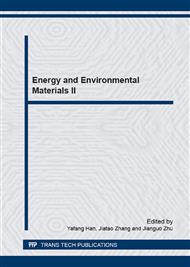[1]
M.B. Tomson, G. Fu; M.A. Watson, A.T. Kan, Mechanisms of Mineral Scale Inhibition, Paper SPE 84958, (2002) 192-193.
Google Scholar
[2]
Leon.J. A, Scott.E. M, Characterization and Control of Formation Damage During Water Flooding at High Clay content Reservoir, Paper SPE 16234, (1987) 8- 10.
Google Scholar
[3]
Moghadasi. J, Jamialahmadi. M, Müller-Steinhagen. H, Sharif. A, Ghalambor. A, Izadpanah.M. R and Motaie E., Scale Formation in Iranian Oil Reservoir and Production Equipment during Water Injection, Paper SPE 80406, (2003) 29- 30.
DOI: 10.2118/80406-ms
Google Scholar
[4]
J. Moghadasi, M. Jamialahmadi, H. Müller-Steinhagen, A. Sharif, Scale Formation in Oil Reservoir and Production Equipment during Water Injection (Kinetics of CaSO4 and CaCO3 Crystal Growth and Effect on Formation Damage), the SPE European Formation Damage Conference held in The Hague, Netherlands, Paper SPE 82233, (2003).
DOI: 10.2118/82233-ms
Google Scholar
[5]
R. Touir, M. Cenoui, M. El. Bakri, M. Ebn. Touhami, Sodium gluconate as corrosion and scale inhibitor of ordinary steel in simulated cooling water, Corrosion Science, 50 (2008) 1530- 1532.
DOI: 10.1016/j.corsci.2008.02.011
Google Scholar
[6]
P.R. Puckorius, B., Cunningham, Cooling water technology advanced course, Presented at International Water Conference, Pittsburgh, (1997).
Google Scholar
[7]
Yuping Zhang, Harry Shaw, Rod Farquhar, Richard Dawe, The kinetics of carbonate scaling—application for the prediction of downhole carbonate scaling, Journal of Petroleum Science and Engineering, 29(2001) 85–95.
DOI: 10.1016/s0920-4105(00)00095-4
Google Scholar
[8]
Yongming Tang, Wenzhong Yang, Xiaoshuang Yin, Ying Liu, Pengwei Yin, Jintang Wang, Investigation of CaCO3 scale inhibition by PAA, ATMP and PAPEMP, Desalination, 228 (2008) 55–60.
DOI: 10.1016/j.desal.2007.08.006
Google Scholar
[9]
Qingfeng Yang, Yangqiao Liu, Anzhong Gu, Jie Ding, Ziqiu Shen, Investigation of Calcium Carbonate Scaling Inhibition and Scale Morphology by AFM, Journal of Colloid and Interface Science, 240 (2001) 608–621.
DOI: 10.1006/jcis.2001.7669
Google Scholar
[10]
Y. Boulahlib-Bendaouda, Samira. Ghizellaoui, Use Of The HEDP For The Inhibition Of The Tartar Of Ground Waters, Energy Procedia, 18 (2012) 1501- 1502.
DOI: 10.1016/j.egypro.2012.05.167
Google Scholar
[11]
Yonghong SUN, Wenhua XIANG, Ying WANG, Study on polyepoxysuccinic acid reverse osmosis scale inhibitor, Journal of Environmental Sciences, 21 (2009) 73.
DOI: 10.1016/s1001-0742(09)60041-3
Google Scholar
[12]
S.J. Dyer, G.M. Graham, The effect of temperature and pressure on oilfield scale formation, Journal of Petroleum Science and Engineering, 35 (2002) 95–107.
DOI: 10.1016/s0920-4105(02)00217-6
Google Scholar
[13]
Amer Badr BinMerdhah, Inhibition of barium sulfate scale at high-barium formation water, Journal of Petroleum Science and Engineering. 90–91 (2012) 124–130.
DOI: 10.1016/j.petrol.2012.04.005
Google Scholar


